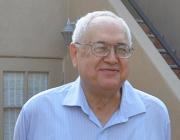Date Published:
APR 26Abstract:
We present an exploration of proton transfer dynamics in a monosaccharide, based upon ab initio molecular dynamic (AIMD) simulations, conducted ``on-the-fly'', in beta-D-galactose-H+ (beta Gal-H+) and its singly hydrated complex, beta Gal-H+-H2O. Prior structural calculations identify O6 as the preferred protonation site for O-methyl alpha-D-galactopyranoside, but the beta-anomeric configuration favors the inversion of the pyranose ring from the C-4(1) chair configuration, to C-1(4), and the formation of proton bridges to the (axial) O1 and O3 sites. In the hydrated complex, however, the proton bonds to the water molecule inserted between the O6 and Ow sites, and the ring retains its original C-4(1) conformation, supported by a circular network of co-operatively linked hydrogen bonds. Two distinct proton transfer processes, operating over a time scale of 10 ps, have been identified in beta Gal-H+ at 500 K One of them leads to chemical reaction and the formation of an oxacarbenium ion (accompanied by the loss of an H2O molecule). In the hydrated complex, beta Gal-H+-H2O, this reaction is suppressed, and the proton transfer, which involves multiple jumps between the sugar and the H2O creates an H3O+ ion, relevant, perhaps, to the reactivity of protonated sugars both in the gas and condensed phases. Anticipating future spectroscopic investigations, the vibrational spectra of beta Gal-H+ and beta Gal-H+-H2O have also been computed through AIMD simulations conducted at average temperatures of 300 and 40 K and also through vibrational self-consistent field (VSCF) calculations at 0 K
